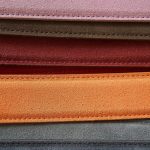Are you ready to learn how to sew minky fabric to cotton?
This step-by-step guide will walk you through the process, ensuring that your fabrics are securely joined together.
From choosing the right needle and thread to finishing the seams, we’ve got you covered.
With our helpful tips and tricks, you’ll be able to create beautiful projects with ease.
So grab your sewing machine and let’s get started!
Table of Contents
Choosing the Right Needle and Thread
You’ll want to make sure you’re using the right needle and thread when sewing minky fabric to cotton. Needle selection is crucial for a successful sewing project. When working with minky fabric, it’s best to use a ballpoint or stretch needle. These needles have a rounded tip that slides between the fibers of the fabric, preventing snags and tears. The ballpoint or stretch needle also helps to maintain the integrity of the cotton fabric, preventing it from getting stretched or distorted during the sewing process.
In addition to needle selection, paying attention to thread tension is essential. Minky fabric is plush and can be quite thick, while cotton fabric is usually thinner. To ensure that the two fabrics are sewn together seamlessly, you’ll need to adjust your thread tension accordingly. A too-tight tension can cause puckering on the cotton fabric, while a too-loose tension can result in loose stitches that may unravel over time. It’s recommended to test the tension on scrap fabric before starting your project to ensure that it is balanced and produces neat and even stitches.
Preparing the Fabric for Sewing
When it comes to sewing, fabric compatibility is key to achieving seamless results. To ensure your project turns out perfectly, there are a few tips to keep in mind.
First, make sure to choose fabrics that are compatible in terms of weight and stretch.
Additionally, prepping your fabric by washing and ironing it will help to eliminate any potential issues during the sewing process.
Fabric Compatibility Tips
To ensure successful sewing, it’s important to consider the compatibility of the minky fabric with the cotton fabric. Here are four tips to help you achieve the best results:
-
Fabric Care: Before sewing, it’s crucial to properly care for both fabrics. Follow the care instructions provided by the manufacturer to ensure that the fabrics are clean, free from stains, and have been pre-shrunk if necessary.
-
Test Stitch: Before starting your project, it’s a good idea to test stitch a small sample of the fabrics together. This will allow you to check for any potential issues and make adjustments if needed.
-
Needle and Thread: When sewing minky fabric to cotton, it’s important to use the right needle and thread. A ballpoint needle and polyester thread are recommended as they will glide smoothly through the fabrics without causing any damage.
-
Troubleshooting Problems: If you encounter any issues while sewing, such as skipped stitches or puckering, try adjusting the tension on your sewing machine or using a walking foot to ensure even feeding of the fabrics.
Prepping for Seamless Sewing
For a seamless sewing experience, make sure you properly prep both materials. When working with slippery fabrics like minky and cotton, it’s important to take extra care to ensure your sewing project turns out beautifully. To help you achieve the best results, here are some useful tips and sewing machine troubleshooting techniques.
First, make sure to wash and press both fabrics before you start sewing. This will remove any dirt or chemicals that might interfere with the stitching process. Next, consider using a stabilizer or interfacing to add stability and prevent stretching or distortion. Pinning the fabrics together before sewing can also help keep them in place.
Additionally, adjusting your sewing machine settings is crucial when working with slippery fabrics. Lower the presser foot pressure to prevent the fabric from getting pulled or stretched. Using a walking foot or a Teflon foot can also aid in smoothly feeding the fabric through the machine.
To further illustrate these tips, here is a table summarizing the key points:
| Tips for Sewing with Slippery Fabrics |
|---|
| 1. Wash and press fabrics beforehand |
| 2. Use stabilizer or interfacing |
| 3. Pin fabrics together before sewing |
| 4. Adjust sewing machine settings |
Pinning and Aligning the Minky and Cotton Fabrics
When it comes to pinning and aligning minky and cotton fabrics, it is important to use the right techniques to ensure a smooth and professional finish.
Start by placing the fabrics right sides together and using straight pins to secure them in place, making sure to pin along the edges and corners.
To ensure proper alignment, use a ruler or a tape measure to measure and mark the desired seam allowance before pinning, and make adjustments as needed.
Pinning Techniques for Alignment
Start by carefully aligning the minky fabric and cotton together before pinning. Proper fabric alignment is crucial for achieving professional-looking sewing projects.
Here are four pinning techniques to help you achieve accurate fabric alignment:
-
Begin by placing the minky and cotton fabrics right sides together, ensuring that the edges are perfectly aligned.
-
Use pins to secure the fabrics together along the edges. Insert the pins perpendicular to the fabric, about 1-2 inches apart.
-
Be mindful of the pattern or design on your fabric. Align the motifs or stripes carefully to maintain a visually pleasing outcome.
-
Take your time to smooth out any wrinkles or puckering between the fabrics. This will ensure a smooth and even seam when sewing.
Ensuring Smooth Fabric Joining
To achieve a smooth join between the two materials, make sure you carefully align and pin them together before sewing.
Smooth fabric handling is key to preventing fabric bunching and achieving a professional-looking result.
Start by placing the minky fabric and cotton fabric right sides together, ensuring that the edges are lined up perfectly.
Use pins to secure the fabrics in place, placing them close together to prevent any shifting during sewing.
When sewing, go slowly and use a sharp needle to avoid any snags or pulls in the fabric.
Hold the fabrics taut as you sew, but be careful not to stretch or distort them.
Sewing the Fabrics Together
Make sure you’re using a ballpoint needle when sewing minky fabric to cotton. This type of needle is designed to avoid snagging or damaging the delicate fibers of the minky fabric.
Now that you have the right needle, let’s explore some sewing techniques to help you achieve a seamless join between these two fabrics.
Here are four essential tips for sewing minky fabric to cotton:
-
Use a longer stitch length: A longer stitch length will help prevent the fabric from puckering or stretching out of shape. Set your machine to a stitch length of around 3mm.
-
Pin or clip the fabrics together: Minky fabric has a tendency to shift or stretch while sewing, so it’s crucial to secure it in place. Use plenty of pins or sewing clips to hold the fabrics together before stitching.
-
Start with a scrap piece of fabric: Before sewing your actual project, it’s a good idea to practice on a scrap piece of minky and cotton fabric. This will allow you to adjust your machine settings and get a feel for how the fabrics behave together.
-
Take your time and go slow: Sewing minky fabric to cotton requires patience and precision. Take your time and sew slowly, ensuring that the fabrics are feeding evenly through your machine.
Following these sewing techniques and paying attention to fabric maintenance will help you achieve a professional-looking finish when sewing minky fabric to cotton.
Finishing the Seams
Once you’ve finished sewing the seams, remember to trim any excess thread for a clean and polished look. Seam finishing techniques are crucial in completing your sewing project with a professional touch.
There are several methods you can use to finish your seams, depending on the fabric and the desired outcome. One popular technique is the zigzag stitch. Set your sewing machine to a zigzag stitch and sew along the raw edges of the seam allowance. This will prevent fraying and give your seam a neat appearance.
Another option is the serger, which trims the fabric edges while simultaneously encasing them in a tight stitch. If you don’t have a serger, you can use pinking shears to cut a zigzag pattern along the edges of the seam allowance. This will help prevent fraying and give your seam a clean finish.
Troubleshooting common sewing issues is essential to ensure your finished project looks professional. If you encounter a skipped stitch, check your needle and thread tension. A dull needle or incorrect tension can cause skipped stitches. If you notice puckering or gathering along the seam, adjust your stitch length and tension. Experiment with different settings until you achieve the desired result.
Pressing and Ironing the Finished Project
After you’ve finished your project, it’s important to press and iron it for a clean and polished appearance. Ironing not only smooths out any wrinkles, but it also helps to set the seams and give your project a professional finish. Here are some ironing techniques and troubleshooting tips to ensure your project turns out perfect:
-
Use the right temperature: Different fabrics require different heat settings. Always check the fabric care label and adjust your iron accordingly to avoid scorching or melting.
-
Steam it up: Steam can be your best friend when it comes to ironing. It helps relax the fibers and remove stubborn creases. Fill the iron with distilled water and use the steam function in short bursts, keeping the iron a few inches away from the fabric.
-
Press, don’t drag: Instead of sliding the iron back and forth, press it down firmly on the fabric for a few seconds, lift, and then move to the next section. This prevents stretching or distorting the fabric.
-
Troubleshooting common issues: If you encounter stubborn wrinkles or creases, try spraying a little water on the fabric and then ironing it. For delicate fabrics, place a pressing cloth or a thin towel between the iron and the fabric to protect it from direct heat.
Tips and Tricks for Sewing With Minky and Cotton
To achieve the best results when working with minky and cotton, it’s important to choose the right needle size for your sewing machine. When sewing with minky fabric, it’s recommended to use a ballpoint needle or a stretch needle. These needles have a rounded tip that helps prevent snags and pulls in the fabric. For cotton, a universal needle or a sharp needle works well.
When handling minky fabric, it’s important to be gentle as it can stretch and shift easily. To avoid this, use pins sparingly and opt for clips or wonder clips instead. When sewing minky to cotton, it’s best to place the minky fabric on the bottom to prevent the feed dogs from pushing the fabric down and causing it to stretch.
When it comes to sewing techniques, keep in mind that minky fabric has a nap, meaning the fibers lie in a particular direction. Be sure to cut your fabric pieces in the same direction to maintain consistency. Additionally, when sewing minky to cotton, use a longer stitch length to prevent the minky from getting caught in the feed dogs.
Conclusion
In conclusion, sewing minky fabric to cotton can be a rewarding project with the right tools and techniques.
Remember to choose the appropriate needle and thread for the job, and prepare your fabrics by washing and ironing them beforehand.
Take your time to pin and align the fabrics accurately, and sew them together using a straight stitch or a zigzag stitch for added durability.
Finish the seams by trimming and pressing them, and don’t forget to give your finished project a final press and ironing for a polished look.
With these tips and tricks, you’ll be able to create beautiful and cozy creations with minky and cotton fabrics.
Happy sewing!
- Tetron Fabric for Marine Applications: Durability and Use Cases - June 18, 2025
- Tetron Fabric for Outdoor Furniture: Weather Resistance and Care - June 18, 2025
- Tetron Fabric for Wall Coverings: Style and Application Tips - June 18, 2025




